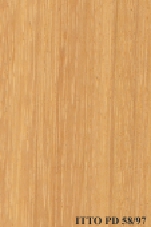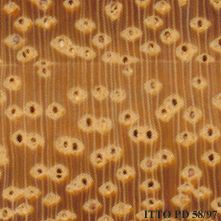
DOUSSIé (Afzelia pachyloba)
Nom commercial
Doussié
Nom scientifique (avec auteur)
Afzelia pachyloba Harms
Famille
LEGUMINOSAE
Noms communs (pays)
Pau conta (Guinea-Bissau); Afzelia (United States of America); Afzelia (Germany); N'kokongo (Congo); M'banga (Cameroon); N'kokongo (Angola); Azodau (Côte d`Ivoire); Lingue (Côte d`Ivoire); N`kokongo (Congo); Doussie (Cameroon); M`banga (Cameroon); N`kokongo (Angola); Uvala (Angola); Bolengu (Zaire); Chanfuta (United States of America); Afzelia (United Kingdom); Mkora (Tanzania); Mbembakofi (Tanzania); Kpendei (Sierra Leone); Lingue (Senegal); Chanfuta (Portugal); Apa (Nigeria); Aligna (Nigeria); Mussacossa (Mozambique); Chanfuta (Mozambique); Pauconta (Guinea-Bissau); Papao (Ghana)
Synonymes du nom scientifique (avec auteurs)
Afzelia zenkeri Harms; Afzelia caudata Hoyle; Afzelia brieyi De Wild.
DESCRIPTION DE L'ARBRE
Description botanique
It reaches heights of 26 to 40 m, with a diameter up to 100 to 170 cm and more. The boles are clear, up to 10 to 16 m in length. Large irregular buttresses are sometimes present.
Habitat naturel
Afzelia pachyloba occurs in dense evergreen forests. The tree reaches its best development on moist sites. It is known or inferred that the harvesting of specimens from the wild for international trade has, or may have, a detrimental impact on the species
Répartition naturelle
West and Central Africa, from Guinea to Angola.
IDENTIFICATION DU BOIS
Description anatomique du bois
Wood diffuse porous. Occasionally vessels exclusively solitary (over 90%). Tangential diameter of vessel lumina 200 micras or more (large). Vestured pits. Vessels per mm2 less than 6 (rare). Simple perforation plates. Vessel-ray pits similar to intervessel pits Axial parenchyma in marginal or in seemingly marginal bands. Axial parenchyma lozenge-aliform. Prismatic crystals in chambered axial parenchyma cells and/or in fibers. 3 to 4 cells per parenchyma strand. 4 to 10 rays per mm (medium). Rays non-storied. Rays 1 to 4 seriate. Homogeneous rays and/or sub-homogeneous rays (all ray cells procumbent). Non-septate fibers. Fibers with simple to minutely bordered pits.
-
 Vue macroscopique du bois (plan tangentiel)
Vue macroscopique du bois (plan tangentiel)
-
 Vue microscopique d'une section transversale du bois
Vue microscopique d'une section transversale du bois
Disponibilité
Statut CITES
Unrestricted
DESCRIPTION GÉNÉRALE DU BOIS
Teinte
The sapwood is whitish to pale yellow, it has a thickness of 2 to 5 cm. The heartwood is reddish brown, it is clearly demarcated.
Index de Teinte (1 = Noir, 7 = Jaune clair)
6
Grain
Straight or slightly interlocked, sometimes with an influence on further processing operations.
Texture
The wood is typically coarse in texture.
Durabilité naturelle
Very durable to decay; without preservative treatment. This species is especially suited for all the uses with risks of permanent or long-lasting humidification. Resistant to termites attack. Heartwood is resistant to Lyctus attacks.
Index de durabilité naturelle (1 = Très élevée, 7 = Très faible)
1
Tensions internes de croissance
Residual stresses are reported to be absent.
Résistance à l'imprégnation
Nearly impossible to treat with a too much low penetration of the preservative substances.
PROPRIÉTÉS PHYSIQUES DU BOIS
Densité basale ou gravité spécifique (poids anhydre/vol. saturé) (g/cm³)
0.6708647894
Densité sèche à l'air (poids et volume à 12%TH) (g/cm³)
0.75
Retrait tangentiel total (saturé à 0%TH) (%)
4.9
Retrait radial total (saturé à 0%TH) (%)
3.3
Calendrier de séchage en séchoir recommandé
FR-6
Ratio de stabilité dimensionnelle (% retrait tangentiel total/% retrait radial total)
1.5
Calendrier de séchage en séchoir
http://www.tropicaltimber.info/wp-content/uploads/2015/09/KD_French.pdf
PROPRIÉTÉS CHIMIQUES DU BOIS
PROPRIÉTÉS MÉCANIQUES DU BOIS
Résistance à la flexion (module de rupture_MOR) 12%TH (kgf/cm²)
1142
Rigidité (module d'élasticité_ MOE) 12%TH (kgf/cm²)
178976
Résistance à la compression parallèle à la fibre 12%TH (kgf/cm²)
735
Résistance à la compression perpendiculaire à la fibre 12%TH (kgf/cm²)
104
Résistance au cisaillement (radial) 12%TH (kgf/cm²)
81
Dureté Janka (latérale) 12%TH (kgf)
700
Dureté Janka (extrémités) 12%TH (kgf)
788
OUVRABILITÉ
Sciage
Sawing of this species requires powerful equipment.
Coupe de placage de déroulage
Suitable for slicing.
Placage tranche
Suitable for slicing.
Effet d'émoussement
Moderate blunting effect; stellited blades for sawing and carbide tools for machining are advised.
Usinage
It needs powerful tools for processing. Possible difficulties caused by interlocked grain are reported.
Rabotage
Moderately easy; tools must be cautiously sharpened.
Moulurage
Easy; no particular problems.
Tournage
30
Perçage
Easy; no particular problems.
Mortaisage
Easy; no particular problems.
Clouage
Pre-boring is necessary.
Collage
Difficult to glue because of the extracts content.
Ponçage
Easy to perform; it gives good results.
Polissage
Needs pre-coating.
Cintrage à la vapeur
This species can be used for steam bending.
Compatibilité avec outils manuels
Working with hand tools is difficult.
UTILISATIONS
UTILISATIONS FINALES (RÉSUMÉ)
HOUSING GENERAL, beams, joists, boards, flooring, parquet, frames, steps, panelling, fittings, FURNITURE AND CABINETS, luxury furniture, cabinets, PLYWOOD AND VENEER, Decorative veneer, TURNING, ornaments, turned furniture, CONTAINERS, cooperage, NAVAL CONSTRUCTION, boats, boat hulls, boat deck, port storage, OTHER AND MUSICAL INSTRUMENTS, shingle
MEUBLES ET M. DE RANGEMENT
- 10 - Silica in Timbers
Pouters
- 11 - Prospect: The wood database
Solives
- 12 - Tropical timbers of the world. Part I-Tropical American Species
Planches
- 13 - Dry kiln schedules for commercial woods. Temperate and tropical. Section III. Latin American (Mexico, Central, and South America) Woods–Conventional Temperatures
Planchers
- 14 - Handbook of Hardwoods
Parquets
- 15 - Empire Timbers
Cadres
- 16 - Woods of the World
Marches
- 17 - Tree Conservation Database
Panneaux
- 18 - W3TROPICOS Missouri Botanical Garden
Accessoires en bois
- 19 - Silica in Timbers
MEUBLES ET M. DE RANGEMENT
- 21 - Tropical timbers of the world. Part III-Southeast Asian and Oceanian Species.
Meubles luxe
- 22 - Dry kiln schedules for commercial woods. Temperate and tropical. Section IV-Asian and Oceanian Woods
Armoires
- 24 - Empire Timbers
PANNEAUX ET PLACAGE
- 25 - Directory of Timber Trade Malaysia
Placage tranché
- 28 - Ministry of Agriculture, Fisheries & Forest of Fiji
Tournage
- 30 - Embassy of Honduras in Japan
Ornements
- 31 - Embassy of Colombia in Japan
Ornements
- 32 - Embassy of Cote d`Ivoire in Japan
Tonnellerie
- 51 - Recopilacion de propiedades mecanicas de maderas creciendo en Chile
CONSTRUCTION NAVALE
- 55 - Tropical Timber Atlas of Latin America
Navires
- 56 - Manual de Identificación de Especies Forestales de la Subregión Andina.
Navires_coques
- 57 - Estadísticas de Aprovechamiento, Exportación y comercialización Nacional de Productos Forestales
Navires_ponts
- 59 - Programa Nacional de uso Sostenible de los Bosques e Incremento a las Exportaciones.
Port entreposage
- 62 - Estudio Tecnológico de Maderas del Perú (Zona Pucallpa) Vol I
Shingles
- 77 - Amazonian Timbers, Characteristics and Utilization Volume I; Tapajós National Forest
Please Provide Information To View Producer Information